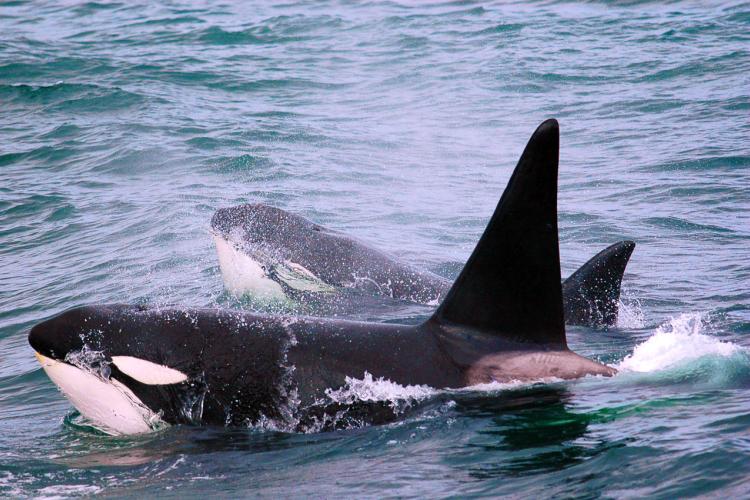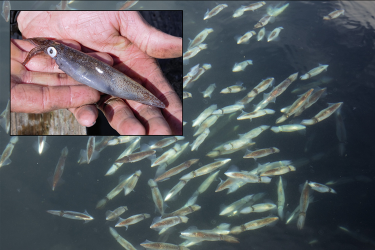History
The National Marine Mammal Laboratory’s Cetacean Assessment and Ecology Program has a continuing project to study predation on marine mammals by “transient”-type (mammal-eating) killer whales in the Aleutian Islands. Initiated in 2001, the program investigates the potential role of killer whales in the decline of the western stock of Steller sea lions.
Predation on Steller sea lions in the eastern Aleutians has been visually observed to be ~14% of all transient predation events, and stable isotope values of transient killer whales there are consistent with a diet composed of 14% Steller sea lions (Herman et al. 2005, Marine Ecology Progress Series; Krahn et al. 2007, Marine Environmental Research). Acoustic recorders at sea lion rookeries and satellite tagging of killer whales have confirmed foraging movements consistent with some predation on Steller sea lions in the eastern Aleutians. For example, transient killer whales were heard regularly via an acoustic recorder at the Ugamak Island Steller sea lion rookery near Unimak Pass (unpublished data); a kill of a sea lion by a killer whale was observed at that rookery; and satellite tag locations of a transient killer whale showed it to be foraging in areas adjacent to that same rookery (J. Durban and Wade, unpublished data).

Why the western and central Aleutian Islands?
The focus of current research has shifted to the western and central Aleutian Islands because of the continuing decline or lack of recovery of Steller sea lions in that area. No observations have been made of predation on Steller sea lions in the western and central Aleutians, but observation effort there has been relatively sparse.
Previously, the only predation events observed during our surveys in the central and western Aleutians were of a Dall’s porpoise and a Baird’s beaked whale. Additionally, Estes et al. described predation on sea otters in the central Aleutians.
What Have We Observed?
Transient Killer Whale Population Estimates of the Central and Western Aleutian Islands
During Marine Mammal Laboratory surveys, transient killer whales have been regularly seen in two areas in the central and western Aleutian Islands:
- the Delarof Islands-Tanaga Island area
- Kiska Island and the Rat Islands
With abundance estimated at approximately 90 whales.
A population of killer whales of this size could potentially inhibit the recovery of Steller sea lions in this region if they were a primary prey of transient killer whales there.
Dietary Analysis
Killer whales integrate chemical tracers acquired from their prey (e.g., stable isotope ratios of nitrogen and carbon) that reflect both the species consumed and the regions from which the prey were taken (Krahn et al. 2007). Analysis of blubber samples collected from transient killer whales reveals that the nitrogen stable isotope (δ15N) values of transient killer whales in the western Aleutians (Kiska Island and the Rat Islands) are much lower than values of transients in the eastern Aleutians and Bering Sea.
However, nitrogen values in the central Aleutians (Delarof Islands-Tanaga Island) show dramatically different patterns: two of the samples group with the western Aleutian samples, and two of the samples group with the eastern Aleutian samples. The low western and central Aleutian samples have values from 12.5 to 14 δ15N, whereas, the majority of the eastern Aleutian samples have values from 16 to 19.5 δ15N.
Given a trophic shift of ~3.8, this means that some transient killer whales in the central and western Aleutians are feeding on prey with an average δ15N value of ~8.7-10.2. This appears to be too low a δ15N value to be primarily from marine mammals, as observed values from marine mammals have all been higher: minke whales (central Aleutians, ~12.3 δ15N), Dall’s porpoise (eastern Aleutians, ~12.6 δ15N), sea otters (central Aleutians, ~13.4 and ~15.3 δ15N), and Steller sea lions (central Aleutians, average value of 15.8 δ15N) (Wade et al. 2006, North Pacific Research Board Final Report; unpublished data).
One possible explanation for the low killer whale nitrogen values comes from a single observation of transient killer whales near Kiska Island feeding on squid in 2006 (J. Durban, unpublished data). Some species of squid have δ15N values in the range of ~8.7-10.2, suggesting that predation on squid may explain the low nitrogen values observed in killer whales in the western Aleutians and in some killer whales in the central Aleutians.
On the other hand, two transient killer whales from the central Aleutians had δ15N values over 17 and over 20, which is consistent with a diet composed primarily of Steller sea lions.
The stable isotope results therefore suggest there may be two types of transient killer whales in the central Aleutians, or at least killer whales with two different foraging strategies. Interestingly, recent genetic studies we have conducted have concluded that a population boundary for transient killer whales exists in the central Aleutians, suggesting the possibility of the overlap of two populations there.
Satellite Tagging
Location-only satellite tags (N=4) have also elucidated two dramatically different foraging strategies, with some killer whales moving ~1,000 nautical miles south of the Aleutians (far outside the range of Steller sea lions). Other killer whales remained in a single location over deep water at the head of a submarine canyon for an entire month (see Figure 1 above), a foraging behavior not previously observed in transient killer whales. While it is possible these killer whales were foraging at the surface on marine mammals the entire time, it seems unlikely.
Although we have often seen sperm whales and beaked whales in habitat over submarine canyons in the Aleutian Islands, their stable isotope values from the central Aleutians are 15.2 δ15N (sperm whales) and 16.3 δ15N (Baird’s beaked whales), respectively. Such values are again too high for them to be substantial prey of killer whales, which are characterized by a range of 12.5-14 δ15N. A month spent foraging over a submarine canyon, combined with the predation observation and stable isotope data summarized above, suggests the hypothesis that these killer whales were foraging on squid.
Further research is continuing by piggy-backing on the Marine Mammal Laboratory's Steller sea lion research cruises.
A proposal to the Pollock Conservation Research Cooperative, with co-investigators Russ Andrews (University of Alaska Fairbanks) and John Durban (Southwest Fisheries Science Center), has provided funds to deploy Mk10-A satellite-linked depth tags on transient killer whales in the western and central Aleutians to track their movements and, importantly, record their diving behavior. Diving information will allow us to estimate what proportion of the time transients in the region are pursuing a deep-diving foraging strategy; this potentially represents time spent foraging on squid and not on Steller sea lions.
Acoustic Studies
Additional support from the North Pacific Fisheries Foundation has allowed us to expand our acoustic recorder work into the central and western Aleutians.
Locations
Three recorders were deployed in late October 2012 adjacent to Steller sea lion rookeries in the Delarof Islands, Kiska Island, and Agattu Island.
How the Data Will Be Used
The recorders were on a 15% duty cycle (45 seconds recorded every 5 minutes) in order to record the presence of killer whales (from both acoustic calls and echolocation clicks). The recorder data will be used to determine whether transient killer whales regularly occur around Steller sea lion rookeries in the western and central Aleutians, and whether their rate of occurrence is similar to rates seen in the eastern Aleutians.
Contact




